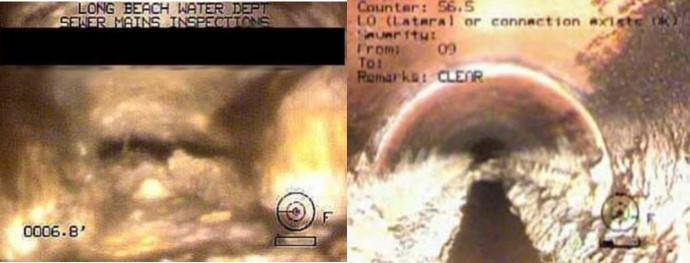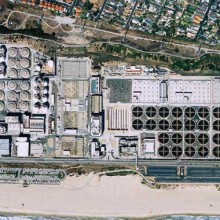John May: Infrastructuralism: The pathology of negative externalities

Quaderns #262
code: 26203
Today we are told that our modern lives are in crisis, and that our infrastructures are mostly to blame. That although they undoubtedly once served us well, our infrastructures are in need of a generalized modernization—a Green Modernization, whatever that may mean—so that their capacity for resolving the calamities of modern life might be made commensurate with our expanded scope of influence. Infrastructures, on this logic, must be made to function ‘more efficiently’—energetically, financially, etc.—so that they may assist us in managing our deteriorating environment. In any case, efficiency is the order of the day.
But what does it mean to say that an infrastructural system is efficiently managing its environment? Consider two instances within a discrete category of infrastructural concerns: the problem of human effluence, or bodily waste.
In the early years of its growth, Chicago sat on a completely flat expanse of bedrock. At that time, the population dealt with its problem of effluence with a simple system of open drainage ditches. But by the middle of the nineteenth century, these ditches had become open channels of stagnant wastewater, which by mid-century came to be seen as a threat to human health. The city addressed this problem by way of a two-step, ten-year, ‘modernization’ project.
First, the entire downtown—which until then had sat on perfectly flat bedrock—was raised by several meters, in order to provide it a slope adequate to ensure proper rates of flow. Next, the first underground sewerage system in the United States was buried within the newly created slope. The project was completed in 1870, and in terms of relative expenditure and effort was far more radical than anything being proposed by infrastructural advocates today. Was the project a solution to the problem of Chicago’s effluent? We can return to that question. In any case, it certainly ensured that the effluent would efficiently flow away from the downtown.
Now take a more recent example, the Hyperion treatment plant, which is Los Angeles’ largest wastewater treatment facility—one of the largest in the world, in fact. Initially built in 1894 as a raw sewage discharge point into the Santa Monica Bay, it was “upgraded” during the 1970’s through a series of modernization efforts. It now “processes and treats 360 million-gallons per day,” and is generally regarded as one of the great American environmental achievements of the 20th Century.
Though spaced nearly one hundred years from one another, we find in each case, I think, two ways of understanding this very modern notion of ‘functionally efficient’ infrastructures. The first is through the lens of the kind of managerial discourse just quoted; that is, through the lens of a specific kind of language in which life is regarded first and foremost as a set of problems that can be managed through proper techniques of maintenance, monitoring, etc. This is a discourse that replaces the older, normative, deductive concept of ‘solution’ with the far more expansive, flexible and inductive concept of ‘management.’ It is a psychological orientation to the world that has expanded in tandem with the emergence and maturation of the modern bureaucracy, and the adiaphorization that typifies its subjects. Under the suzerainty of this logic, problems—which, in other words, are no longer solved-solved, but instead managed-solved—are rendered as sets of statistical monitoring data whose extents are actively confined to a certain range through processes of parameterization and regulation. This is ‘environmental management’ today.
But there is a second possibility, a second view onto these conditions, in which infrastructural elements like Hyperion function as remarkably convincing images of functionality. If we admit, for example, that Hyperion belongs to a system encompassing some 6500 miles of sewage lines, which during this decade alone has averaged roughly 600 Category 1 “sewage events” each year, and which itself sits within an even larger territorial system that, according to biologists, released some 28 million gallons of raw sewage into California waterways during 2008 alone…
Only when certain undeniable realities are made to illuminate the dark space beneath the rhetoric of managerial discourse—where systemic realities lurk unabashedly; where modernity is shown its own bowels—can we recognize that facilities like Hyperion are playing an active and highly visible role in the grand myth of manageability that we confer upon our infrastructures. Put differently: since their radical extension during the nineteenth century modern infrastructures have carried out their assigned tasks by ensuring the ‘proper’ distribution of the contents of modernity—cleanliness, comfort, convenience—by continually externalizing its discontents.
This strategy of negative externality has taken place simultaneously across two registers: conceptually and substantially. Conceptually, through ordinary words such as ‘byproduct,’ ‘waste,’ and ‘side-effects,’ the discontents of infrastructures are continually re-inscribed within a language of systemic functionality. And yet, at the very same time, the substantial material effluence of modernization is continually dispensed along infrastructures to an outside that is simultaneously abstract and real. That outside is simply any designated repository of continually externalized exponential accumulations: the inner city or its territorialized hinterlands; the Global South or the upper atmosphere; the inner lung or the adipose tissue …more or less anywhere beyond the ordinary perceptual grasp of the population specific to an infrastructural intervention.
These accumulations are themselves far more substantial than the pleasures they provide. The infrastructure of human effluent in the name of hygiene; the infrastructure of the commodity in the name of capital; the infrastructure of animal ‘processing’ in the name of appetite. In each case the managed accumulations outpace the pleasures, such that the functional language of infrastructures has, in a sense, always perfectly misrepresented, or precisely reversed, their material reality.
This has always been the case. The Chicago project instantly and exponentially intensified the amount of human effluent being released at a single point in the Chicago River. It also prepared the ground for a population explosion of staggering proportions, unrivaled in the nineteenth century. Ultimately, the project so quickly and drastically altered the composition of the river that in 1906 Upton Sinclair named its central section “Bubbly Creek,” in reference to the tremendous off-gassing that resulted from the decomposition of human effluent and swine entrails.
Today, at places like Hyperion—that is, at discrete but evident nodes in territorial systems—the concept of management centers on the treatment of effluent, through various processes, until it is ‘safe:’ that is, until its composition has achieved certain statistical-compositional parameters. At that point the liquid effluent is “clean enough to be discharged out at sea, through a 5-mile underwater pipeline.” In other words: everything is externalized, removed from our perceptual frame, substituted with the imagery of managerial prowess.
And here we confront a rather remarkable feature of this perceptual ruse: that even the so-called failures associated with these systems have come to reify and reinforce the grand theater of modern functionalism. The assertion that something has temporarily failed is of course a logical correlate to the assumption that it is usually functioning properly.
Take for example a recent failure that, while larger than average in size, is far from atypical. In 2006, 2 million gallons of raw sewage were released onto a Los Angeles beach in a single spill, when a pumping station immediately south of Hyperion failed. The spill lasted for 14 hours before being reported, and it was later remarked how surprising it was that even the fail-safe back-up alarm system had failed. The accident led authorities to quickly close off the beach while emergency crews tried to repair the pumping station and siphon away the sewage.
Like similar spills, it of course summoned a diverse mixture of elements though which ‘infrastructural events’ are produced—bureaucratically, discursively, sociopsychologically: cinematically. “Real time” mass media; the practices of scenario modeling and accident investigation; the managerial discourses of prevention, monitoring and response; public relations and engineering bravado as a politics of sanitation; the whole, sad spectacle unfolding as an urban dramaturgy of excrement. Hopeful and sincere, surrounding the event on all sides, these elements set the relations of cause and effect. They perform and form a kind of perceptual apparatus in which infrastructural processes are represented first and foremost as localized, brief spectacles; as discrete, fleeting failures within otherwise benign networks; tragic happenings that visit us for short time periods in specific places. This, too, is environmental management: a continual, exaggerated histrionics of functional-infrastructural salvation.
Apart from its many political ramifications (aren’t the most efficient infrastructures also the most effective forms of population control?), one of the disquieting qualities of this generic event-formula is its near total exclusion of the most pressing realities facing the world today. So many of our unfolding catastrophes are simply not amenable to the kinds of spectacular productions to which we have grown accustomed. In most cases they are slow processes, unfolding across months, years, decades, and centuries. Often the scale of their incidence renders them invisible to our methods of documentation: microscopic phenomena comprising accumulations that are, paradoxically, imperceptibly large.
We are presented with two distinct time signatures, one of which actively conceals the other. The first—the managerial time of infrastructures—is the time of statistical reasoning and the calculus of variations. Up-tempo and staccato, it is punctuated by regular crescendos, which we call accidents or malfunctions, and which are immediately attributed to either temporary failures or resolvable localized inefficiencies. Managerial time renders systemic failures un-visible. The second time—the historical time of infrastructures, or the time of accumulations—is a slowly unfolding, long-wave threnody, in which the full extents of modernization are evident.
In the first signature, where the concept of efficiency has been fashioned so as to exclude its own externalizations, our managerial rhetoric makes sense. In the second, that same language appears utterly absurd, contradictory even.
The widespread inability to recognize or acknowledge the historical time of accumulations is the most pronounced and obvious symptom of an entrenched infrastructuralism. Particularly acute today among urbanists and bureaucrats—for whom efficiency is an almost erotic obsession—infrastructuralism is a modern pathology in which the rhetoric and imagery of managerial discourse serve to erase any differentiation between primary and reflexive modernization. Infrastructuralism is marked by the self-veiling of a truth—a terrible truth, unendurable for The Moderns—that the most efficient methods of environmental management are also in fact the most destructive and wasteful. It is a lie we tell ourselves in place of truths that would change us if we were made to face them, and the primary material-moral alibi for the supposed superiority of our limitless, ‘civilized’ lives.
Are we now completely unable to dream of antiinfrastructure? Of urbanisms that do not exists solely at the behest of efficient dispersal, distribution, and externalization? Of populations that are not victims of their own cynical machinery? For now, we simply play out this drama, willingly blinded to the circuitry of its staging.





